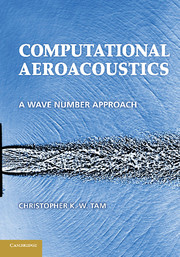Book contents
- Frontmatter
- Contents
- Preface
- 1 Finite Difference Equations
- 2 Spatial Discretization in Wave Number Space
- 3 Time Discretization
- 4 Finite Difference Scheme as Dispersive Waves
- 5 Finite Difference Solution of the Linearized Euler Equations
- 6 Radiation, Outflow, and Wall Boundary Conditions
- 7 The Short Wave Component of Finite Difference Schemes
- 8 Computation of Nonlinear Acoustic Waves
- 9 Advanced Numerical Boundary Treatments
- 10 Time-Domain Impedance Boundary Condition
- 11 Extrapolation and Interpolation
- 12 Multiscales Problems
- Chapter 13 Complex Geometry
- 14 Continuation of a Near-Field Acoustic Solution to the Far Field
- 15 Design of Computational Aeroacoustic Codes
- Appendix A Fourier and Laplace Transforms
- Appendix B The Method of Stationary Phase
- Appendix C The Method of Characteristics
- Appendix D Diffusion Equation
- Appendix E Accelerated Convergence to Steady State
- Appendix F Generation of Broadband Sound Waves with a Prescribed Spectrum by an Energy-Conserving Discretization Method
- Appendix G Sample Computer Programs
- References
- Index
Preface
Published online by Cambridge University Press: 05 October 2012
- Frontmatter
- Contents
- Preface
- 1 Finite Difference Equations
- 2 Spatial Discretization in Wave Number Space
- 3 Time Discretization
- 4 Finite Difference Scheme as Dispersive Waves
- 5 Finite Difference Solution of the Linearized Euler Equations
- 6 Radiation, Outflow, and Wall Boundary Conditions
- 7 The Short Wave Component of Finite Difference Schemes
- 8 Computation of Nonlinear Acoustic Waves
- 9 Advanced Numerical Boundary Treatments
- 10 Time-Domain Impedance Boundary Condition
- 11 Extrapolation and Interpolation
- 12 Multiscales Problems
- Chapter 13 Complex Geometry
- 14 Continuation of a Near-Field Acoustic Solution to the Far Field
- 15 Design of Computational Aeroacoustic Codes
- Appendix A Fourier and Laplace Transforms
- Appendix B The Method of Stationary Phase
- Appendix C The Method of Characteristics
- Appendix D Diffusion Equation
- Appendix E Accelerated Convergence to Steady State
- Appendix F Generation of Broadband Sound Waves with a Prescribed Spectrum by an Energy-Conserving Discretization Method
- Appendix G Sample Computer Programs
- References
- Index
Summary
Computational Aeroacoustics (CAA) is a relatively young research area. It began in earnest fewer than twenty years ago. During this time, CAA algorithms have developed rapidly. These methods soon found applications in many areas of aeroacoustics.
The objective of CAA is not simply to develop computational methods, but also to use these methods to solve real practical aeroacoustics problems. It is also a goal of CAA to perform numerical simulation of aeroacoustic phenomena. By analyzing the simulation data, an investigator can determine noise generation mechanisms and sound propagation processes. Hence, CAA offers a way to obtain a better understanding of the physics of a problem.
Computational Aeroacoustics is not the same as Computational Fluid Dynamics (CFD). In fact, CAA faces a different set of computational challenges, because aeroacoustics problems are intrinsically different from standard aerodynamics and fluid mechanics problems. By definition, aeroacoustics problems are time dependent, whereas aerodynamics and fluid mechanics problems are, in general, time independent or involve only low-frequency unsteadiness.
Information
- Type
- Chapter
- Information
- Computational AeroacousticsA Wave Number Approach, pp. xi - xivPublisher: Cambridge University PressPrint publication year: 2012
